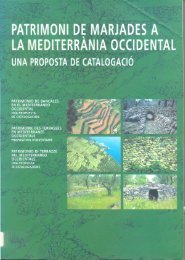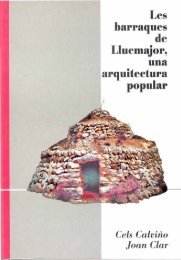La pedra en sec. Materials, eines i tècniques tradicionals a les illes ...
La pedra en sec. Materials, eines i tècniques tradicionals a les illes ...
La pedra en sec. Materials, eines i tècniques tradicionals a les illes ...
You also want an ePaper? Increase the reach of your titles
YUMPU automatically turns print PDFs into web optimized ePapers that Google loves.
***<br />
* *<br />
: * * *: 6 6.6.2 DRYSTONE MASONRY STRUCTURES<br />
Description<br />
Structure made of a drystone masonry<br />
shell, normally round, and with a conical<br />
roof made of trees and plants.<br />
Uses<br />
Dwelling designed to provide temporary<br />
shelter for charcoal workers wh<strong>en</strong><br />
they were making charcoal.<br />
Site<br />
In a evergre<strong>en</strong> oak wood.<br />
Ground Plan<br />
Circular, 2.90 m in diameter inside.<br />
Roofing<br />
Conical and made of trees and plants.<br />
It was built using evergre<strong>en</strong> oak<br />
trunks, some acting as master beams<br />
and the rest laid betwe<strong>en</strong> them.<br />
Reeds were th<strong>en</strong> placed on top until a<br />
waterproof covering was obtained.<br />
Facings<br />
60 cm wide and quite low (1.20 m)<br />
double facing made of undressed<br />
stone.<br />
<strong>Materials</strong><br />
Limestone for the facings and evergre<strong>en</strong><br />
oak trunks and reeds for the<br />
roof.<br />
Flooring<br />
Earth.<br />
Op<strong>en</strong>ings<br />
The only op<strong>en</strong>ing is a small, 40 cm<br />
wide door with only its jambs made of<br />
stone.<br />
Accessory items<br />
Accessory features outside the hut<br />
are a dry stone bread ov<strong>en</strong> plus a<br />
mosquera, or shady spot, made of<br />
pine where the charcoal worker<br />
rested and ate (Calviflo, 1999). As for<br />
charcoal manufacturing structures,<br />
near the hut there is always the charcoal<br />
bunker and quite oft<strong>en</strong> a loading<br />
place where animals would be loaded<br />
with the charcoal.<br />
The bread ov<strong>en</strong> is round and has a<br />
very simple vaulted roof made of stones<br />
laid on <strong>en</strong>d. The only hole is the<br />
op<strong>en</strong>ing which in this case is square<br />
and made of 4 pieces of stone. It is<br />
<strong>en</strong>tirely constructed with barely dressed<br />
limestone with the most dressed<br />
stone forming the op<strong>en</strong>ing.<br />
The charcoal bunker is the round,<br />
paved area of land measuring 7.75 m<br />
in diameter where the charcoal pile<br />
was built. It is made of a course of larger<br />
stones (some 35 cm high) which<br />
form its edge. The space inside is full<br />
of large stones with rubble and very<br />
dry and clayey red earth on top. The<br />
gaps betwe<strong>en</strong> the stones served as<br />
ducts through which a small amount<br />
of air flowed which was suffici<strong>en</strong>t to<br />
fire but not burn the charcoal.<br />
A conical pile or heap of bits of wood<br />
(the sitja) was placed on the charcoal<br />
bunker and covered with earth. The<br />
wood was set on fire and it slowly<br />
burnt to produce charcoal.<br />
Location<br />
Son Macip, Escorca.




